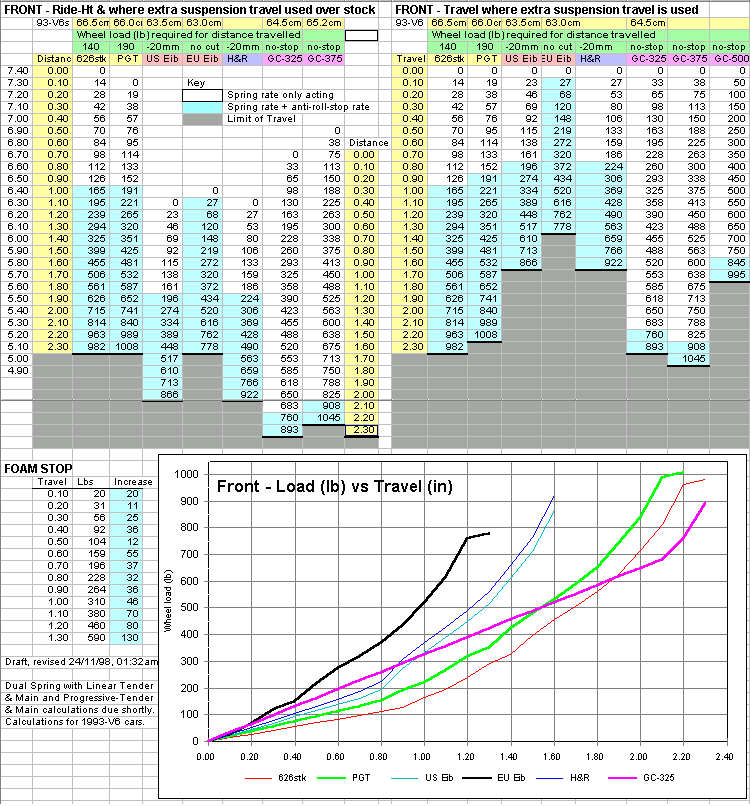


Springs & Anti-roll Bars
Alternative approaches use adjustable coil-over systems. These range
from Ground Control T6061 Anodised aluminium adaptors using 2.5" springs,
through to true double-adjustable coilover-shocks from LEDA, AVO and
others using 2.25" springs.
The rates of the various spring options are shown below graphically
with regard to their profile and suspension travel. The (draft) data
& graph are available in a spreadsheet downloadable in Quattro Pro V6
format susp1.wb2, and in Excel
susp1.xls format.
Ride - An all-linear rate combined with considerable travel avoids harshness
due to sudden rate transitions and limited suspension travel. Such travel is the key
as hitting a pothole at 60mph even with a 325-rate, uses up a full 2" of travel
(linear potentiometer datalogging). In corners an all-linear rate shines, as potholes
in the corner feel no worse than if impacted on in a straight line. Such a linear
ride even in corners is something that the stock suspension can not achieve, instead
crashing into the foam antiroll stops. The dampening rate is slightly under-dampened to
eliminate vibration, passengers being left to enjoy the remaining taut yet unnervingly
supple ride over potholes.
Handling - An all-linear rate provides for the most predictable handling
possible, quite unlike other road cars and much easier to drive and co-operative
when called upon in emergency maneouvres. The rate is sufficiently high to limit roll
below most other spring options both at low & normal speeds, and only at very high
cornering speeds will roll be greater - considering most peoples driving habits this
is a reasonable compromise.
Dampening - Non-linear rates require shock absorbers to be either
under-dampening when the rate is high or over-dampening when the rate is soft, with
both wallow & harshness quickly resulting from poor compromises. The benefit of the
reduced load on shock absorbers & linear rate is audible, with reduced rattles.
Last Upload: 31st January, 2002. V1.50a
 Springs
Springs
Eibachs springs for MX6/626 reduce ride height 25-30mm (UK) or 25mm (US).
H&R offer 35mm drop for the UK. On both, cutting the foam-antiroll-stops
regains some lost suspension travel however on EU-Eibachs their spring-rate
is too low to allow this without a harsh spring-rate transition point
resulting. Eibach-US springs are similar to the softer US (not Euro)
M3 springs, although they will provide less wallow/plough than the low
US M3 front-rate.

 All Linear Spring Rates
All Linear Spring Rates
The use of an all linear spring rate, eg, very long spring (8"), with sufficient
rate (325lb/in for V6s), and slightly-soft dampened (Tokico-3) provides an excellent
compromise between ride & handling. The use of very long springs is unconventional and
breaks the miss-perception of single "high" rates being rough. The miss-perception
assumes little travel and that the stock spring-rate is 190lb/in, when in reality the
anti-roll foam-stop rate (300lb/in+) is additive resulting in 490lb/in+ rates. To
contrast the EU-Eibach rate is even higher than a single 500lb/in rate.
 Spinal Advantage
Spinal Advantage
Drivers or passengers with spinal problems will probably prefer an all linear
rate, as it does not load the body with jolts from sudden rate-increases. For example,
softer dampening on stock suspension can be counter productive: the higher rate is
impacted on more per unit time due to the reduced dampening (ironically). A 8"-300lb/in
rate will ride better but provides less road feel, and less travel so custom 8.5-300s
are probably the ideal unless real coilovers are used.
 Real coilovers
Real coilovers
Real coilovers (LEDA, AVO, etc) allow the use of a tender/main spring setup
(225/450lb/in) or progressive-tender/main setup (170/250/450) so with tuning a better
ride (softer-initial) and handling (less roll) can be achieved. The stock anti-roll
kinaesthmatic foam-stop solution follows this school of thought, but lacks tuning and
later 95+ cars simply raised ride height in an awful aesthetic/handling attempt to
improve ride: kin-unaesthetic stops. Many prefer all-metal spring solutions as the
foam-stops vary in rate with temperature, just as wheel-rate (tire/tyre) varies
similarly and the ride can be better on a warm day with with warm tyres than a cold day
with cold tyres. The true ideal is a custom taper-wound spring (as used by Porsche on
the 935) which has no sharp transition points to deteriorate handling or ride.
 Anti-roll Bars
Anti-roll Bars
Anti-roll bars have a benefit for road cars in providing only an increased spring
rate in corners, thus having less impact on ride than typical uprated springs. Offerings
range from Eibach (Xedos6/MX6/626/PGT in Europe) with 19mm rear and uprated front bar,
to Mazda Competition rear bar (16mm) and Addco rear bar (22mm), stock rear being a
toothpick or 12mm in size. Eibach Europe delivery timeline on bars is several months.

URL: http://homepage.ntlworld.com/dorothy.bradbury/probemx/p_sa2.htm